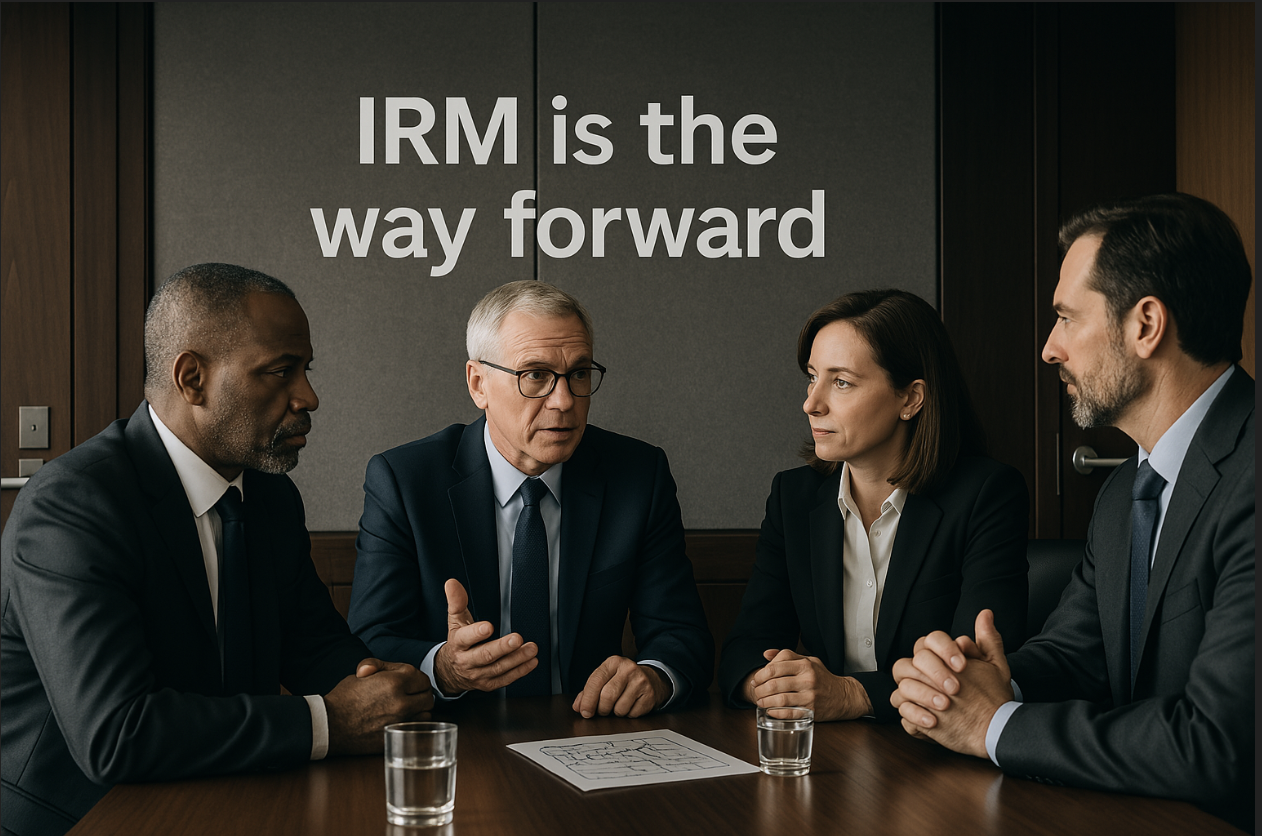
Click here to access subscription content at The RTJ Bridge - The Premium Version of The RiskTech Journal
〰️
Click here to access subscription content at The RTJ Bridge - The Premium Version of The RiskTech Journal 〰️
The RiskTech Journal
The RiskTech Journal is your premier source for insights on cutting-edge risk management technologies. We deliver expert analysis, industry trends, and practical solutions to help professionals stay ahead in an ever-changing risk landscape. Join us to explore the innovations shaping the future of risk management.

From Code to Conduct: UK Cyber Mandate and Tech Disruption Signal a Governance Reckoning
Two significant announcements this week—one from the UK government and the other from Deloitte—highlight a rapidly converging future in which cybersecurity, advanced technology, and corporate governance are no longer siloed concerns but integrated imperatives for the boardroom. While distinct in origin and focus, both developments send a clear signal: the pressure on executive leaders to govern technology risks with discipline, foresight, and accountability is mounting.

When Encryption Isn't Enough—A Sidewalk Interview and a Global Wake-Up Call
I was in Washington, D.C., when the story broke. Reports surfaced that U.S. officials had used Signal—a consumer-grade encrypted messaging app—to coordinate sensitive military operations in Yemen. I was finishing a dinner meeting after a full day of engagements when my phone rang. It was the BBC reaching out for immediate commentary on a fast-developing national security story.

Why Generative AI Is Breaking Cyber Insurance—and What Risk Leaders Must Do Next
The promise of generative artificial intelligence (AI) is captivating: it automates content creation, accelerates decision-making, and unlocks new efficiencies across industries. But beneath this glittering facade lurks an existential threat that few executives acknowledge: these systems are introducing catastrophic risks that cyber insurance markets are neither prepared for—nor willing to underwrite fully. As insurers frantically scramble to recalibrate policies in light of AI-driven threats, risk executives face a stark choice: transform how they manage emerging digital risks or face potentially devastating uninsured losses.

The Limits of Legacy GRC — Seven Reasons It Fails Modern Risk Management
In the corridors of risk management conferences and behind closed doors at technology vendor meetings, there's a reluctant acknowledgment that few are willing to voice publicly — traditional Governance, Risk, and Compliance (GRC) platforms are struggling to meet the demands of today's dynamic risk landscape. As someone who has spent decades consulting with both GRC vendors and their customers, I've heard the whispered confessions from technology providers who recognize these limitations but fear alienating their long-standing clients by admitting them openly.

The Great Risk Revolution—Why GRC Alone Can't Save Your Organization
In boardrooms across the globe, a quiet revolution is underway. Organizations that once viewed risk management primarily through the lens of Governance, Risk, and Compliance (GRC) are discovering—often the hard way—that yesterday's frameworks are increasingly inadequate for today's complex threat landscape.
Consider this. When the World Economic Forum recently surveyed global executives, the most pressing concerns they identified—from AI disruption to supply chain vulnerabilities—weren’t neatly contained within traditional GRC boundaries. These risks cascade across organizational silos, render conventional approaches obsolete, and demand a fundamentally different way of thinking about organizational resilience.

Risk Rewired — Why CROs Must Lead the Charge in the New Era of Digital-First Risk Management
For the first time in over a decade, not a single financial risk made it into the top 10 concerns for chief risk officers (CROs). Instead, cybersecurity (75%), operational resilience (38%), and geopolitical volatility (36%) dominate the agenda. These are not just new threats—they are structurally different, externally driven, and deeply interconnected. Managing them demands a new kind of leadership—one capable of navigating a risk matrix that is faster, flatter, and far more fragile than ever before.
Chief Risk Officers now stand at the intersection of technology, strategy, and trust. The question is no longer whether they have a seat at the table. It’s whether they’re prepared to lead the table—or risk becoming sidelined as the world moves ahead without them.

Audit at the Edge: Governing AI Before It Governs You
Artificial intelligence is no longer a side project buried in IT. It’s now embedded in decision-making processes across finance, operations, marketing, and customer service. From algorithmic underwriting to autonomous workforce tools, AI is transforming how businesses operate—and how they fail. Yet for many organizations, Internal Audit remains stuck in the past: buried in compliance checklists, siloed in function, and reliant on legacy Governance, Risk, and Compliance (GRC) systems incapable of keeping pace.

Moving Beyond the GRC Mindset - Why Boards Must Rethink Risk for the AI Era
I’m often questioned—sometimes challenged and occasionally attacked—by professionals who are deeply invested in traditional Governance, Risk, and Compliance (GRC) approaches. For many, GRC isn’t just a framework or a set of tools—it’s an identity, a career foundation, and in many cases, a commercial interest. So when I suggest that risk management must evolve beyond legacy GRC models, I’m not just raising a strategic argument—I’m challenging a belief system.
But this is not about abandoning GRC. It’s about recognizing that GRC, in its traditional, siloed, compliance-first form, is no longer sufficient for today’s risk environment.

What Happens When Risk Protocols Fail - Lessons from the Signal App Incident
When BBC News investigated a recent national security communications breach, they reached out to Wheelhouse Advisors for expert analysis. The incident highlighted a growing risk not just for governments—but for every organization managing sensitive information in a digital world.

AI's Risk Reckoning: How Integrated Risk Management Can Prevent Catastrophe
Organizations must adopt a structured, enterprise-wide approach to AI risk governance to balance AI's opportunities and risks. Integrated Risk Management (IRM) provides the governance framework to manage AI risks holistically, aligning AI implementation with corporate strategy, regulatory compliance, cybersecurity, and operational resilience.

HIPAA 2.0 — How Risk Management Evolves Under HIPAA’s Cybersecurity Overhaul
In the face of escalating cyber threats, the U.S. healthcare sector is on the brink of its most dramatic regulatory transformation in more than a decade. The Department of Health and Human Services’ recent Notice of Proposed Rulemaking (NPRM) for the HIPAA Security Rule doesn’t just update a long-standing framework—it signals a revolutionary shift in how organizations must guard patient data. The stakes are higher than ever, with compliance costs set to soar and the consequences of non-compliance more severe than ever imagined.

The Future of Risk Management - How AI Agents Are Transforming IRM
Artificial Intelligence (AI) agents are revolutionizing Integrated Risk Management (IRM) by enabling organizations to detect, analyze, and mitigate risks autonomously. Unlike traditional risk management frameworks that rely heavily on manual assessments and static controls, AI-driven solutions enhance speed, accuracy, and adaptability, reducing financial losses, security breaches, and compliance failures.

The Challenges of AI Agents and Why Risk Management Matters
Artificial intelligence (AI) agents are being promoted as game-changers for businesses, helping automate tasks, reduce costs, and improve efficiency. However, recent research from CB Insights shows that many companies using AI agents face three significant problems: unreliable performance, complex integration with existing systems, and lack of uniqueness among different AI solutions. These issues highlight why businesses need Integrated Risk Management (IRM)—a structured way to handle risks related to AI, including security, compliance, and performance challenges. Without proper oversight, AI agents can cause more harm than good.

Bridging the Resilience Gap: Why Integrated Risk Management Outperforms Legacy GRC Solutions
A recent KPMG Risk & Resilience Survey (March 2025) has revealed a concerning reality: most U.S. organizations remain unprepared to handle increasing risk events and broad disruptions. The report highlights that two-thirds to nearly three-quarters of organizations face moderate to strong barriers to managing risk effectively. The survey findings confirm a critical gap in how organizations manage risk and, more importantly, where traditional Governance, Risk, and Compliance (GRC) technologies fall short.

Distilled Intelligence or Compressed Catastrophe? The High-Stakes Risks of Shrinking AI
Their is a great deal of hype about distilled AI, an emerging technique that trims down massive machine learning models into leaner, cheaper versions. While these distilled “student” models may look—and sometimes perform—much like their full-fledged AI counterparts, a closer inspection reveals a labyrinth of potential flaws: from amplified bias and reduced accuracy to hidden legal liabilities.

The Digital Risk Paradox - Why Corporate Digitalization Could Be Your Biggest Liability
Digital transformation has long been heralded as the corporate world's silver bullet—promising efficiency, resilience, and competitive advantage. However, emerging research suggests a more unsettling reality: the rush to digitalize may create as many risks as it mitigates.

Moving Fast and Breaking Things - The Hidden Risks of AI's Silent Upgrades
In recent months, an increasing number of organizations across finance, healthcare, and technology sectors have encountered significant disruptions caused by seemingly minor updates to their AI-driven tools. For instance, compliance teams at major financial institutions faced confusion and heightened regulatory exposure when an incremental update to their AI language models altered interpretations of regulatory guidance overnight. Without clear prior communication from the AI vendor, these subtle but impactful changes created significant operational uncertainty and regulatory scrutiny.

Europe’s Regulatory Rollercoaster: Echoes of Sarbanes-Oxley in the Green Deal Pivot
Europe's ambitious Green Deal, launched in 2019 as the centerpiece of the EU’s climate action, is now caught in the all-too-familiar pendulum swing of regulatory evolution. The European Commission, under mounting pressure from industries grappling with soaring energy prices and layers of complex regulation, has signaled a notable pivot. Yet, EU leaders maintain they are not abandoning their climate ambitions but rather seeking balance between sustainability and economic competitiveness.

Citi's $81 Trillion Error Highlights Urgent Need for Stronger Integrated Risk Management
The startling news that Citigroup mistakenly credited a client’s account with $81 trillion instead of a mere $280 underscores a critical weakness pervasive in today’s financial institutions: insufficiently robust integrated risk management (IRM) systems. This incident, termed a “near miss” by Citi, reveals deep-seated operational vulnerabilities that continue to plague banks, despite considerable investment and regulatory scrutiny.

Security Complexity Is Strangling Your Bottom Line—IRM Platforms Can Save It
By now, it’s obvious: complexity has become the Achilles’ heel of cybersecurity and enterprise risk management (ERM). In a recent study from the IBM Institute for Business Value—Capturing the Cybersecurity Dividend: How Security Platforms Generate Business Value—researchers found that companies juggle an average of 83 different security solutions, sourced from 29 distinct vendors. Beyond the technology overload lies a crucial lesson for risk leaders: more point solutions do not necessarily translate into better protection.
